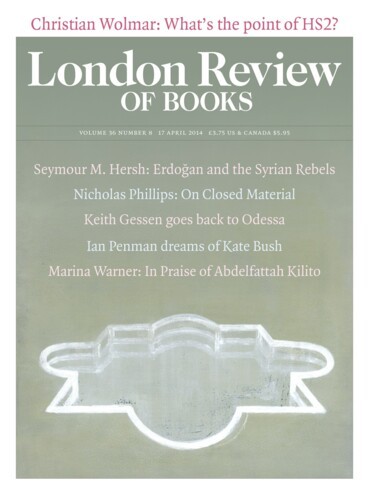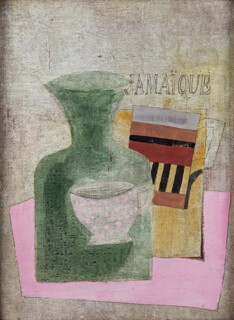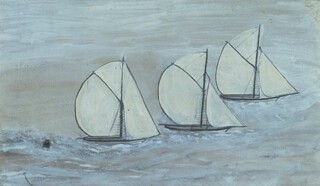When Ben Nicholson and Winifred Roberts got married, in 1920, they had everything they wanted: time and leisure to paint in, and enough of Winifred’s family money to travel wherever they liked. On their honeymoon they passed through Venice, Florence, Rome, Naples, Amalfi, Pisa, Portofino, Rapallo and Genoa. They rented – and later, with the help of Winifred’s father, a former undersecretary of state for India, bought – a house above Lake Lugano in Switzerland, near the Italian border. ‘We do absolutely nothing,’ Winifred wrote in a letter home, ‘but paint all day, eat supper and tea at 6.30 wash brushes and prepare canvases, go to bed and dream painting. Sometimes we go for a walk to look for new painty things.’ They painted the same views, Ben with a moody, dynamic interest in shapes and shadows, Winifred taking in crazy Alpine trees in a colourful, exuberant rush. In Paris, they assessed – and were generally dismissive of – the art happening there. Derain, Picasso and Matisse were good, but ‘bar select few,’ Ben wrote, ‘they … have all lost the pt of painting & are “modern”, dated, local. It is all froth.’ The Nicholsons were very sure of themselves, though by the time they were back in Britain for good it was Winifred whose paintings sold.
In the exhibition at Kettle’s Yard in Cambridge (until 11 May, after which it moves to Dulwich Picture Gallery), Winifred and Ben’s paintings from the ten years in which they lived together are hung side by side. Ben’s still lifes are of empty vessels: jugs, bowls and pots standing together, in formal, Morandi-like fashion. By contrast, Winifred’s focus is on the foliage inside the jug, and her pots and vases overflow with buds, petals and leaves. She was greatly admired as a colourist: she had ‘an uncanny sense of flowers’, the Times said, and showed ‘genius’. Her Cyclamen and Primula (1922-23) is all purples and mauves, against blue-grey hills that fade into a paler sky. She was encouraging and solicitous of Ben. In a letter of 1925 she suggested he try out a pink she was particularly pleased with: ‘Have you tried Jaune capucine Foncé its rather a good pale pink.’ Obediently, he used it in a still life called c.1925 (Jamaïque): a grey cup, with pink dots, stands with other objects on a square of pink cloth. The pretty colour, here, doesn’t fit the picture: the cup and cloth could have been bought in a shop of the nicer sort, and they seem merely decorative.
By this stage, at least some of the time (Ben in particular didn’t like being pinned down), they were working in a studio on the King’s Road in Chelsea. The exhibition makes much of the similarity between Ben’s 1924 (First Abstract Painting, Chelsea) and Winifred’s King’s Road, Chelsea from 1925. But the comparison is fanciful: Ben’s painting is a simulated collage done in oils of overlapping squares and angles, and Winifred’s is a picture of some flowers on a windowsill with romantic garret-like roofs behind. They did largely share a palette – but perhaps that’s because, living together, they shared paints too.
As they got known around London – they befriended the Tate curator Jim Ede, who bought many of their pictures and went on to design and live in the house and gallery at Kettle’s Yard – they in turn patronised other artists. To their house in Cumbria they invited Christopher Wood, who hadn’t managed to sell much, though Winifred, never less than enthusiastic, said of him: ‘Here was England’s first painter. His vision is true, his grasp real, his power is life itself.’ Ben and Kit would go out walking together with their easels and equipment, and practise simplifying the landscape they saw until they were drawing just the bare essentials. Ben’s exercises here were notably better than Wood’s. But Wood was happy – ‘My hosts are charming,’ he wrote to his mother, ‘and this rather spartan existence becomes very pleasant and restful and one does nothing but work all day’ – and he was soon exhibiting regularly with the Seven and Five Society, which the Nicholsons ran.
Wood’s work started to look more and more like Winifred’s. Travelling with them in Cornwall he painted The Fisherman’s Farewell, a portrait of Ben, Winifred and their one-year-old son, Jake, standing against St Ives harbour: Ben and Jake are posed much as they are in Winifred’s Father and Son, from the previous year, though in Wood’s picture the child is performing a Christ-like benediction. Wood’s Anemones in a Cornish Window is even more plainly modelled on Winifred’s work, but the buildings in the background beyond the flowers, small and square and box-like, are taken from Ben. He was grateful to them, and loyal.
Ben’s painting, meanwhile, was turning into something else. In Cornwall he came across the work of Alfred Wallis, a local fisherman turned self-taught painter:
on the way back from Porthmeor Beach we passed an open door in Back Road West and through it saw some paintings of ships and houses on odd pieces of paper and cardboard nailed up all over the wall, with particularly large nails through the smallest ones. We knocked on the door and inside found Wallis, and the paintings we got from him then were the first he made.
Most of Wallis’s work was done on cardboard. He also painted on utensils, furniture, used vegetable boxes and many of the spare surfaces in his house. He used boat paint, which was easily found in St Ives, and came in a limited range of colours: grey, white, black, brown, blue, green. The houses in Wallis’s pictures, like his boats, all seem to be in motion, pitched at an angle; his seas and skies are rough and scratched on. Ben praised his ‘formidable organisation’ and his ‘rhythm’, and said he was as good as Mondrian or Miró. Wallis himself, explaining his work, wrote: ‘What I do mosley is what use To Bee out of my own memery what we may never see again.’ Ben became Wallis’s champion – talking him up in the usual Nicholson way – and his unofficial dealer, showing his work to all his friends in London: Barbara Hepworth, Herbert Read, Adrian Stokes and Jim Ede all became supporters. How much he affected Ben’s work is clear from the Kettle’s Yard show. For his part, Wallis went on painting as he always had, despite his new celebrity. He spent his last years in the Madron Institute, a workhouse in Penzance; Ben would occasionally visit with supplies of boat paint.
Things didn’t turn out too well for Kit Wood either. By 1930 he was short of money, unable to marry his mistress and addicted to opium. Now, the Nicholsons seemed only to remind him of what he didn’t have. After an unsuccessful show with Ben in Paris, where his work was barely noticed, he wrote to his mother: ‘My life is unlivable, so the Nicholsons think. I think the same of theirs.’ He set off for home in mid-August, and in a fit of paranoia, threw his opium and pipes out of a train window. The day after getting back he had lunch with his mother and sister. They dropped him off at Salisbury station and 25 minutes later he jumped in front of a train. On hearing the news, Ben wrote to Jim Ede: ‘He was like one’s own most beautiful child, of one’s own age – we did try to help him – tried & tried.’ The Nicholsons, on the other hand, had no difficulty helping each other out. In 1931, Ben left Winifred and their children (there were now three of them) to live with Barbara Hepworth, but they kept on being nice about each other’s work, even when Ben’s – at last – became the thing to have.
Send Letters To:
The Editor
London Review of Books,
28 Little Russell Street
London, WC1A 2HN
letters@lrb.co.uk
Please include name, address, and a telephone number.



